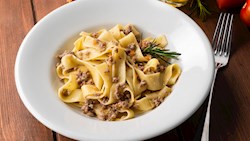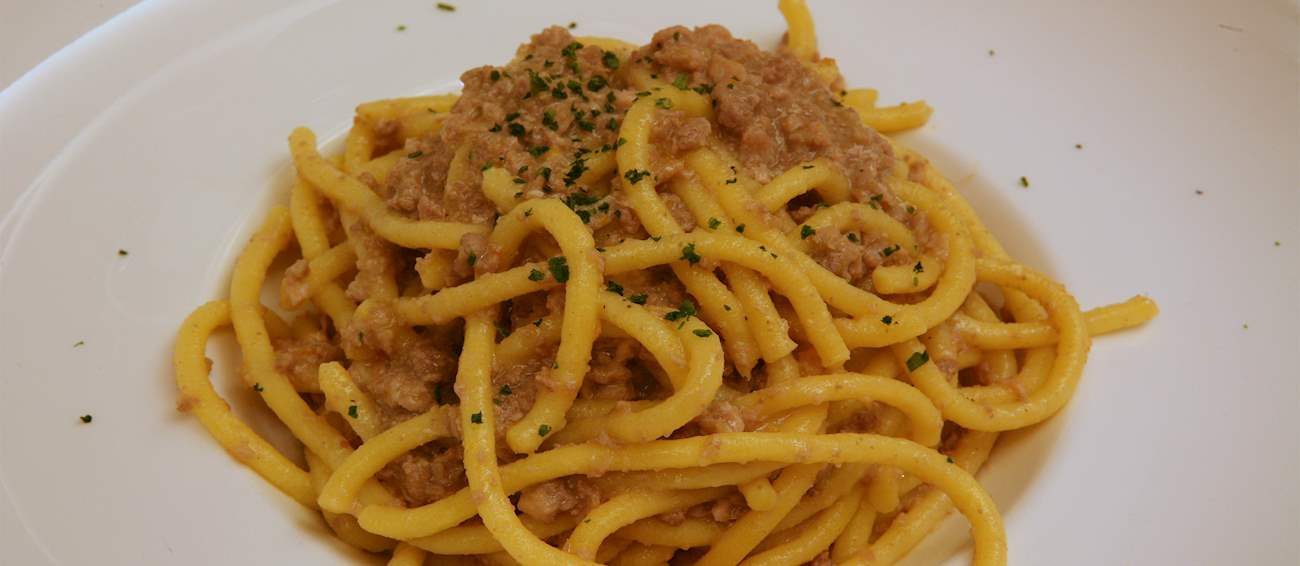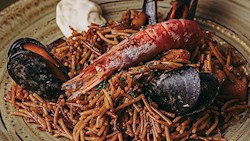Pasta 'ncasciata is a traditional pasta dish originating from Sicily. In order to prepare it, pasta such as penne or rigatoni is cooked in boiling water, then strained and mixed with a rich tomato sauce (in Palermo) or a beef ragu (in Messina), cubes of fried eggplant, pieces of cheese such as caciocavallo or mozzarella, and bechamel sauce.
The combination is placed in a springform cake tin, sprinkled with breadcrumbs, then baked until the filling becomes hot. The dish is inverted from the mold and served warm. It's recommended to pair it with a glass of red wine such as Nero d'Avola or Frappato.
Serve with
MAIN INGREDIENTS
I bigoli con l'anatra, locally known as bigoi co' l'arna, is a traditional dish that originated in the city of Thiene, but over time it became very popular throughout the province of Vicenza. Bigoli is a thick, egg-based pasta variety whose size and texture make the perfect match for a rich duck ragú made with onions, carrots, celery, bay leaves, sage, and dry white wine.
Originally, this dish used to be prepared with cleaned offals and duck fat, while duck meat was either used in other recipes or preserved in fat. Nowadays, only the best parts of meat and livers are used, while duck fat is substituted with butter and olive oil - the result is an equally delicious, yet much lighter dish.
MAIN INGREDIENTS
The carbonara we know today is prepared by simply tossing spaghetti with guanciale (cured pork jowl), egg yolks, and Pecorino Romano cheese. Despite its simplicity, this dish remains one of Rome's favorites, equally popular throughout the country.
Even though carbonara is considered a typical Roman dish today, its origins are quite vague and often disputed. The name is said to have been derived from the carbonari, woodcutters and charcoal-makers who lived in the Appenine mountains northeast of Rome, and who supposedly cooked their pasta over a hardwood charcoal fire and tossed it with eggs and cheese.
MOST ICONIC Carbonara
View moreTagliatelle al ragù alla Bolognese is a traditional dish originating from Bologna, consisting of tagliatelle pasta and a rich ragù made with a mixture of minced beef and pork, and tomatoes as key ingredients. Even though they are often thought to be synonymous, tagliatelle al ragù—one of Bologna's signature dishes—bears little or no resemblance to the dish known as spaghetti Bolognese in the rest of the world.
In fact, the world famous Italian ragù alla Bolognese meat sauce is never served with spaghetti in Bologna. Instead, when it isn't served over fresh tagliatelle, you will most often find it topping a bed of some other other ribbon-like pasta, such as fettuccine or pappardelle.
Serve with
MOST ICONIC Tagliatelle al ragù alla Bolognese
View moreMAIN INGREDIENTS
This rich and filling piatto unico (lit. single plate; one-dish meal) is traditionally made from layers of homemade, typically spinach-flavored fresh egg lasagna pasta that is topped with béchamel sauce and a rich meat sauce called ragù alla Bolognese.
Lastly, lasagne alla Bolognese is generously sprinkled with the Emilian king of cheeses, Parmigiano-Reggiano, and baked until tender on the inside with a perfectly crisp, browned top. This oven-baked classic is a typical dish of the Emilia-Romagna region, and of the city of Bologna specifically.
Serve with
MOST ICONIC Lasagne alla Bolognese
View moreNamed after Amatrice, a provincial town in the Sabine Hills northeast of Rome; the iconic Amatriciana sauce is often considered a part of the "holy trinity of Roman pasta", together with carbonara and cacio e pepe. Amatriciana was invented in the 17th century by adding tomatoes to the already famous gricia sauce – diced tomatoes are sautéed in fat rendered from juicy bits of guanciale (cured pork jowl), then tossed together with grated pecorino cheese and either spaghetti or bucatini pasta.
The first recipe for Amatriciana was published in the 1790 cookbook L’Apicio Moderno by Francesco Leonardi, a renowned Roman chef and author. Over time, this classic Italian dish became so popular it was featured in several movies, from Alberto Sordi’s 1954 film An American in Rome and Luciano Salce’s 1978 Where Are You Going on Holiday? to Ryan Murphy’s Eat Pray Love, in which Julia Roberts joyfully wolfs down a portion of spaghetti all’Amatriciana while sitting on the terrace of a typical Roman osteria.
MOST ICONIC Amatriciana
View moreMAIN INGREDIENTS
One of Italy's all-time favorites, linguine allo scoglio, often also dubbed linguine ai frutti di mare is a typical southern Italian seafood dish or piatto di mare. Back in the 1980s in the wider Neapolitan area, as well as along the entire southern Italian coast, there was reportedly not a single restaurant that didn't offer some version of such a timeless classic on its menu.
This pasta entrée is made with either linguine or spaghetti, and a combination of seafood and shellfish, preferably coming from fresh local catch of the day. Considering seafood seasonality, what Neapolitan and any other scoglio (lit. reef; rock) has to offer varies from month to month, so there is no precise recipe for this dish, and there are countless variations in existence, but the most traditional ones always include clams, mussels, shrimps, and sometimes even calamaretti or baby squids.
Serve with
MOST ICONIC Linguine allo scoglio
View moreMAIN INGREDIENTS
A variety of Italian pasta ripiena (lit. filled pasta), agnolotti are tender, bite-sized pillows of dough, plump with a creamy cheese, meat, or vegetable filling. Agnolotti originated in the Piedmont region circa 12th century, and they are often regarded as the first of many stuffed pasta types in northern Italian cuisine.
Unlike ravioli, which are made with two separate pasta sheets and stamped out, agnolotti are made with a single sheet of dough that is folded over the filling and typically cut into little rectangles. However, throughout the region, agnolotti come in various shapes.
Serve with
VARIATIONS OF Agnolotti
MOST ICONIC Agnolotti
View moreMAIN INGREDIENTS
As with so many classic Italian dishes, the story of pasta alla gricia is one of unclear and often disputed origin. Pasta alla gricia is sometimes called amatriciana bianca (lit. white amatriciana), which reflects the common root of these two pasta dishes, though gricia is known to be older than the tomato-based amatriciana sauce.
Moreover, gricia is said to have originated in Grisciano, a small hamlet not far from Amatrice, the birthplace of spaghetti all'amatriciana. These two mountain towns nestled in the Apennine peaks between the neighboring regions of Lazio and Abruzzo have long been known as home to semi-nomadic shepherds, who were often credited with inventing this simple sauce.
MOST ICONIC Pasta alla gricia
View moreMAIN INGREDIENTS
Pappardelle is a famous Tuscan pasta variety. When paired with ragù di cinghiale (made with wild boar), they become one of the region's best gastronomic experiences. Unlike classic ragù, the one prepared with wild boar has an intense, much stronger flavor achieved by long, slow simmering in a rich sauce of tomatoes and red wine.
The tender meat paired with fresh egg pasta is a combination full of flavors and tradition in every single bite - rich and delicious, topped with a generous amount of chopped fresh parsley and a sprinkle of Parmigiano, pappardelle al ragù di cinghiale make a perfect, comforting winter dish, especially when paired with a glass of Tuscan red wine.
MOST ICONIC Pappardelle al cinghiale
View more

TasteAtlas food rankings are based on the ratings of the TasteAtlas audience, with a series of mechanisms that recognize real users and that ignore bot, nationalist or local patriotic ratings, and give additional value to the ratings of users that the system recognizes as knowledgeable. For the “Top 100 Pasta Dishes in the World” list until January 29, 2025, 17,405 ratings were recorded, of which 13,649 were recognized by the system as legitimate. TasteAtlas Rankings should not be seen as the final global conclusion about food. Their purpose is to promote excellent local foods, instill pride in traditional dishes, and arouse curiosity about dishes you haven’t tried.













































































































